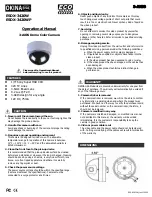
1.5
4. Begin controlling the AutoDome.
5. At the completion of controlling the AutoDome, press Off,
AUX 100 or AUX 101, ENTER.
Changing Ending of Previously Recorded Playback:
1. Execute a single playback.
2. Wait for the playback to reach the point where the change is
desired.
3. Press Off, AUX 50 or AUX 51, ENTER to stop playback.
This step is optional.
4. Press On, AUX 101, ENTER
5. Begin controlling the AutoDome.
6. At the completion of controlling the AutoDome, press Off,
AUX 100 or AUX 101, ENTER.
Erasing A Playback From Some Point In Playback To The
End:
1. Execute a single playback.
2. Wait for the playback to reach the new stopping position.
3. Press Off, AUX 50 or AUX 51, ENTER.
4. Press Set, AUX 500, ENTER.
ON SCREEN DISPLAY ENABLE (AUX60)
When On, on-screen titles and command feedback are
displayed.
ON SCREEN DISPLAY ADJUST (AUX61)
When On, activates an on-screen menu which allows
adjustment of on-screen text brightness, background type, and
vertical position.
COMMAND LOCK/UNLOCK (SET 103/104)
When lock set, prevents access to commands listed for note 7.
NOTES:
1. The following settings are stored with pre-position scenes:
Pan position.
Tilt position.
Zoom position.
Focus mode AUTO/MANUAL.
Focus position for MANUAL mode.
Iris mode AUTO/MANUAL.
Iris ALC/LEVEL for AUTO mode or position for
MANUAL mode.
White Balance mode AUTO/MANUAL (color cameras
only).
Red content and Blue content for MANUAL mode
(color cameras only).
Shutter mode ON/OFF.
Backlight compensation ON/OFF.
2. The following settings are stored as a default setting in
nonvolatile memory (EEPROM) on R/D board and are
used to restore settings at power-up:
Auto-pan left limit = 0 degrees.
Auto-pan right limit = 359.9 degrees.
Auto-pan speed = 30 degrees per second.
Auto-focus activation = OFF
Auto-iris activation = ON.
Auto-speed = OFF.
Spot auto-focus = ON.
Command Lock = OFF (unlocked).
Auto-Shutter = OFF.
Auto-Pivot Enable = ON.
Return Home = OFF
Field of View Optimize = ON.
On-Screen Display Enable = ON.
3. This setting stored as a default setting in nonvolatile
memory in camera.
4. Pre-position #1 (if set) is automatically called-up upon
power-up just after the homing sequence.
5. Scan direction determined by last manual pan direction.
6. Pre-positions can be disabled such that they do not operate
during pre-position tour. They are still available for manual
call-up.
7. Command affected by the Command Lock function.
8. Discontinued when the manual pan control (joystick) is
used
9. Auto-iris and auto-focus revert to manual mode when the
manual iris and focus controls are used, respectively.
Switching to manual iris or manual focus from auto mode
reverts to the last manual setting used.
10. Manual iris is activated automatically upon activating (ON)
Backlight Compensation.
5.4
DIP Switches
Note that the DIP switches may be labeled OPEN in lieu of
OFF and CLOSED in lieu of ON.
S102.5, S102.6, and S107.7:
These DIP switches are used to
set both the pan and tilt speeds when the dome is being
controlled by a system generating “fixed-speed” commands. The
table below lists the maximum speeds when the zoom lens is set
for full wide angle. The speed automatically decreases from the
maximum speed as the lens is adjusted towards the telephoto
settings. At its full telephoto setting, the speed will be decreased
to approximately 12% of its full wide angle speed.
DIP Switch Settings
Maximum Speed
5
6
7
(°/s)
OFF
OFF
OFF
4
ON
OFF
OFF
6
OFF
ON
OFF
10
ON
ON
OFF
15
OFF
OFF
ON
20
ON
OFF
ON
30
OFF
ON
ON
45
ON
ON
ON
60
If the auto-speed feature is enabled (see DIP switch
S102.8
),
these DIP switches apply only to the tilt speed.
S102.8:
This switch controls the Auto-speed feature. When on,
auto-speed is always enabled and control by AUX 16 is ignored;
see
Auto-Speed (AUX 16)
for description. When auto-speed is
enabled, the pan speed starts out slowly and increases as the pan
control is held on. The speed resets to slow when the pan
control is released. The tilt speed is not affected by this switch.
It is still controlled by the setting determined by DIP switches










































